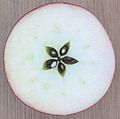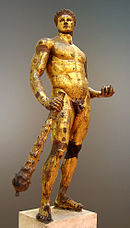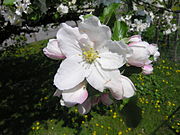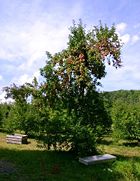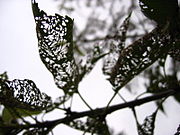
Apple
Did you know...
Arranging a Wikipedia selection for schools in the developing world without internet was an initiative by SOS Children. Click here to find out about child sponsorship.
| Apple | |
|---|---|
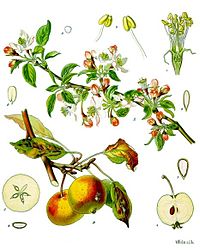 |
|
| Blossoms, fruits, and leaves of the apple tree (Malus domestica) | |
| Scientific classification | |
| Kingdom: | Plantae |
| Division: | Magnoliophyta |
| Class: | Magnoliopsida |
| Order: | Rosales |
| Family: | Rosaceae |
| Subfamily: | Maloideae |
| Genus: | Malus |
| Species: | M. domestica |
| Binomial name | |
| Malus domestica Borkh. |
|
The apple is the pomaceous fruit of the apple tree, species Malus domestica in the rose family Rosaceae. It is one of the most widely cultivated tree fruits. The tree is small and deciduous, reaching 5–12 m tall, with a broad, often densely twiggy crown. The leaves are alternately arranged simple ovals 5–12 cm long and 3–6 cm broad on a 2–5 cm petiole with an acute tip, serrated margin and a slightly downy underside. Flowers are produced in spring simultaneous with the budding of the leaves. The flowers are white with a pink tinge that gradually fades, five petaled, 2.5-3.5 cm in diameter. The fruit matures in autumn, and is typically 5–9 cm diameter. The centre of the fruit contains five carpels arranged in a five-point star, each carpel containing one to three seeds.
The tree originated from Asia, where its wild ancestor is still found today. There are more than 7,500 known cultivars of apples resulting in range of desired characteristics. It should be noted however, that cultivars vary in their yield and the ultimate size of the tree, even when grown on the same rootstock.
Botanical Information
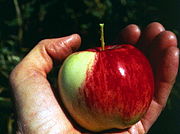
The wild ancestor of Malus domestica is Malus sieversii. It has no common name in English, but is known in Kazakhstan, where it is native, as alma; in fact, the region where it is thought to originate is called Alma-Ata, or "father of the apples". This tree is still found wild in the mountains of Central Asia in southern Kazakhstan, Kyrgyzstan, Tajikistan, and Xinjiang, China.
For many years, there was a debate about whether M. domestica evolved from chance hybridization among various wild species. Recent DNA analysis by Barrie Juniper, Emeritus Fellow in the Department of Plant Sciences at Oxford University and others, has indicated, however, that the hybridization theory is probably false. Instead, it appears that a single species still growing in the Ili Valley on the northern slopes of the Tien Shan mountains at the border of northwest China and the former Soviet Republic of Kazakhstan is the progenitor of the apples we eat today. Leaves taken from trees in this area were analyzed for DNA composition, which showed them all to belong to the species M. sieversii, with some genetic sequences common to M. domestica. Other species that were previously thought to have made contributions to the genome of the domestic apples are Malus baccata and Malus sylvestris, but there is no hard evidence for this in older apple cultivars. These and other Malus species have been used in some recent breeding programmes to develop apples suitable for growing in climates unsuitable for M. domestica, mainly for increased cold tolerance.
History
The centre of diversity of the genus Malus is the eastern Turkey, southwestern Russia region of Asia Minor. The apple tree was perhaps the earliest tree to be cultivated, and their fruits were improved through selection over a period of thousands of years by early farmers. Alexander the Great is credited with finding dwarfed apples in Asia Minor in 300 BC; those he brought back to Greece might have been the progenitors of dwarfing rootstocks. Apples were brought to North America with colonists in the 1600s, and the first apple orchard on this continent was said to be near Boston in 1625. Winter apples, picked in late autumn and stored just above freezing, have been an important food in Asia and Europe for millennia, as well as in Argentina and in the United States since the arrival of Europeans. In the 1900s, irrigation projects in Washington state began and allowed the development of the multi-billion dollar fruit industry, of which the apple is the leading species.
Cultural aspects
Greek mythology
Apples appear in many religious traditions, often as a mystical or forbidden fruit. One of the problems identifying apples in religion, mythology and folktales is that the word "apple" was used as a generic term for all (foreign) fruit, other than berries but including nuts, as late as the 17th C. CE.; For instance, in Greek mythology, the Greek hero Heracles, as a part of his Twelve Labours, was required to travel to the Garden of the Hesperides and pick the golden apples off the Tree of Life growing at its centre.
The Greek goddess of discord, Eris, became disgruntled after she was excluded from the wedding of Peleus and Thetis. In retaliation, she tossed a golden apple inscribed Kallisti ('For the most beautiful one'), into the wedding party. Three goddesses claimed the apple: Hera, Athena, and Aphrodite. Paris of Troy was appointed to select the recipient. After being bribed by both Hera and Athena, Aphrodite tempted him with the most beautiful woman in the world, Helen of Sparta. He awarded the apple to Aphrodite, thus indirectly causing the Trojan War.

A classic depiction of the biblical tale showcasing the apple as a symbol of sin.
Albrecht Dürer, 1507; Oil on panel; 209 x 81 cm (per panel); Museo Nacional del Prado, Madrid. .
Atalanta, also of Greek mythology, raced all her suitors in an attempt to avoid marriage. She outran all but Hippomenes (a.k.a. Melanion, a name possibly derived from melon the Greek word for both "apple" and fruit in general), who defeated her by cunning, not speed. Hippomenes knew that he could not win in a fair race, so he used three golden apples (gifts of Aphrodite, the goddess of love) to distract Atalanta. It took all three apples and all of his speed, but Hippomenes was finally successful, winning the race and Atalanta's hand.
The Bible
Though the forbidden fruit in the Book of Genesis is not identified, popular Christian tradition has held that it was an apple that Eve coaxed Adam to share with her. This may have been the result of Renaissance painters adding elements of Greek mythology into biblical scenes. In this case the unnamed fruit of Eden became an apple under the influence of story of the golden apples in the Garden of Hesperides. As a result, in the story of Adam and Eve the apple became a symbol for knowledge, immortality, temptation, the fall of man into sin, and sin itself. In Latin, the words for 'apple' and for ' evil' are similar in the singular (malum — apple, malus — evil) and identical in the plural (mala). This may also have influenced the apple becoming interpreted as the biblical 'forbidden fruit', although the word malum for apple comes from the Hittite mahla meaning "grapevine, branch" and has nothing to do with malus. The larynx in the human throat has been called Adam's apple because of a notion that it was caused by the forbidden fruit sticking in the throat of Adam. The apple as symbol of sexual seduction has been used to imply sexuality between men, possibly in an ironic vein.
Apple cultivars
There are more than 7,500 known cultivars of apples. Different cultivars are available for temperate and subtropical climates. Reputedly the world's biggest collection of apple cultivars is housed at the National Fruit Collection in England. Apples do not flower in tropical climates because they have a chilling requirement.
Commercially popular apple cultivars are soft but crisp. Other desired qualities in modern commercial apple breeding are a colourful skin, absence of russeting, ease of shipping, lengthy storage ability, high yields, disease resistance, typical " Red Delicious" apple shape, long stem (to allow pesticides to penetrate the top of the fruit), and popular flavour.
Old cultivars are often oddly shaped, russeted, and have a variety of textures and colours. Some find them to have a better flavour than modern cultivators, but may have other problems which make them commercially unviable, such as low yield, liability to disease, or poor tolerance for storage or transport. A few old cultivars are still produced on a large scale, but many have been kept alive by home gardeners and farmers that sell directly to local markets. Many unusual and locally important cultivars with their own unique taste and appearance are out there to discover; apple conservation campaigns have sprung up around the world to preserve such local cultivars from extinction. In the United Kingdom old cultivars such as Cox's Orange Pippin and Egremont Russett are still commercially important even though by modern standards they are low yielding and disease prone.
Although most cultivars are bred for eating fresh (dessert apples), some are cultivated specifically for cooking ( cooking apples) or producing cider. Cider apples are typically too tart and astringent to eat fresh, but they give the beverage a rich flavour that dessert apples cannot.
Modern apples are generally sweeter than older cultivars. Most North Americans and Europeans favour sweet, subacid apples, but tart apples have a strong minority following. Extremely sweet apples with barely any acid flavour are popular in Asia and especially India.
Tastes in apples vary from one person to another and change continually over time. As an example, the U.S. state of Washington made its reputation for apple growing on Red Delicious. In recent years, many apple connoisseurs have come to regard the Red Delicious as inferior to cultivars such as Fuji and Gala due to its merely mild flavour and insufficiently firm texture.
Growing apples
Apple breeding
Like most perennial fruits, apples ordinarily propagate asexually by grafting. Seedling apples are different from their parents, sometimes radically. Most new apple cultivars originate as seedlings, which either arise by chance or are bred by deliberately crossing cultivars with promising characteristics. The words 'seedling', 'pippin', and 'kernel' in the name of an apple cultivar suggest that it originated as a seedling. Apples can also form bud sports (mutations on a single branch). Some bud sports turn out to be improved strains of the parent cultivar. Some differ sufficiently from the parent tree to be considered new cultivars.
By means of crossing, more rigid apples can be achieved by breeders. For example, the Excelsior Experiment Station of the University of Minnesota has, since the 1930s, introduced a steady progression of important hardy apples that are widely grown, both commercially and by backyard orchardists, throughout Minnesota and Wisconsin. Its most important introductions have included ' Haralson' (which is the most widely cultivated apple in Minnesota), 'Wealthy', 'Honeygold', and ' Honeycrisp'.
Pollination
Apples are self-incompatible; they must cross-pollinate to develop fruit. During the flowering each season, apple growers usually provide pollinators to carry the pollen. Honeybee hives are most commonly used. Orchard mason bees are also used as supplemental pollinators in commercial orchards. Bumble bee queens are sometimes present in orchards, but not usually in enough quantity to be significant pollinators.
There are four to seven pollination groups in apples depending on climate:
- Group A – Early flowering, May 1 to 3 in England ( Gravenstein, Red Astrachan)
- Group B – May 4 to 7 ( Idared, McIntosh)
- Group C – Mid-season flowering, May 8 to 11 ( Granny Smith, Cox's Orange Pippin)
- Group D – Mid/Late season flowering, May 12 to 15 ( Golden Delicious, Calville Blanc d'Hiver).
- Group E – Late flowering, May 16 to 18 ( Braeburn, Reinette d'Orléans)
- Group F – May 19 to 23 ( Suntan)
- Group H – May 24 to 28 ( Court Pendu Plat)
One cultivar can be pollinated by a compatible cultivar from the same group or close (A with A or A with B but not A with C or D).
Maturation and harvest
Cultivars vary in their yield and the ultimate size of the tree, even when grown on the same rootstock. Some cultivars, if left unpruned, will grow very large, which allows them to bear a great deal more fruit, but makes harvest very difficult. Mature trees typically bear 40–200 kg of apples each year, though productivity can be close to zero in poor years. Apples are harvested using three-point ladders that are designed to fit amongst the branches. Dwarf trees will bear about 10–80 kg of fruit per year.
Pests and diseases
The trees are susceptible to a number of fungal and bacterial diseases and insect pests. Many commercial orchards pursue an aggressive program of chemical sprays to maintain high fruit quality, tree health, and high yields. A trend in orchard management is the use of organic methods. These use a less aggressive and direct methods of conventional farming. Instead of spraying potent chemicals, often shown to be potentially dangerous and maleficent to the tree in the long run, organic methods include encouraging or discouraging certain cycles and pests.
To control a specific pest, organic growers might encourage the prosperity of its natural predator instead of outright killing it, and with it the natural biochemistry around the tree. Organic apples generally have the same or greater taste than conventionally grown apples, with reduced cosmetic appearances.
Among the most serious disease problems are fireblight, a bacterial disease; and Gymnosporangium rust, apple scab, and black spot, three fungal diseases.
The plum curculio is the most serious insect pest. Others include Apple maggot and codling moth.
Young apple trees are also prone to mammal pests like mice and deer, which feed on the soft bark of the trees, especially in winter.
Commerce
At least 55 million tonnes of apples were grown worldwide in 2005, with a value of about $10 billion. China produced about two-fifths of this total. United States is the second leading producer, with more than 7.5% of the world production. Turkey, France, Italy and Iran are among the leading apple exporters.
In the United States, more than 60% of all the apples sold commercially are grown in Washington state. Imported apples from New Zealand and other more temperate areas are competing with US production and increasing each year.
Human consumption
Apples can be canned, juiced, and optionally fermented to produce apple juice, cider, ciderkin, vinegar, and pectin. Distilled apple cider produces the spirits applejack and Calvados. Apple wine can also be made. They make a popular lunchbox fruit as well.
Apples are an important ingredient in many winter desserts, for example apple pie, apple crumble, apple crisp and apple cake. They are often eaten baked or stewed, and they can also be dried and eaten or re-constituted (soaked in water, alcohol or some other liquid) for later use. Puréed apples are generally known as apple sauce. Apples are also made into apple butter and apple jelly. They are also used (cooked) in meat dishes.
- In the UK, a toffee apple is a traditional confection made by coating an apple in hot toffee and allowing it to cool. Similar treats in the US are candy apples (coated in a hard shell of crystallised sugar syrup), and caramel apples, coated with cooled caramel.
- Apples are eaten with honey at the Jewish New Year of Rosh Hashanah to symbolize a sweet new year.
- Farms with apple orchards may open them to the public, so consumers may themselves pick the apples they will buy.
Sliced apples turn brown with exposure to air due to the conversion of natural phenolic substances into melanin upon exposure to oxygen. Different cultivars differ in their propensity to brown after slicing. Sliced fruit can be treated with acidulated water to prevent this effect.
Organic apples are commonly produced in the United States. Organic production is difficult in Europe, though a few orchards have done so with commercial success, using disease-resistant cultivars and the very best cultural controls. The latest tool in the organic repertoire is a spray of a light coating of kaolin clay, which forms a physical barrier to some pests, and also helps prevent apple sun scald.
Health benefits
| Nutritional value per 100 g (3.5 oz) | |
|---|---|
| Energy | 218 kJ (52 kcal) |
| Carbohydrates | 13.81 g |
| - Sugars | 10.39 g |
| - Dietary fibre | 2.4 g |
| Fat | 0.17 g |
| Protein | 0.26 g |
| Vitamin A equiv. | 3 μg (0%) |
| Thiamine (vit. B1) | 0.017 mg (1%) |
| Riboflavin (vit. B2) | 0.026 mg (2%) |
| Niacin (vit. B3) | 0.091 mg (1%) |
| Pantothenic acid (B5) | 0.061 mg (1%) |
| Vitamin B6 | 0.041 mg (3%) |
| Folate (vit. B9) | 3 μg (1%) |
| Vitamin C | 4.6 mg (6%) |
| Calcium | 6 mg (1%) |
| Iron | 0.12 mg (1%) |
| Magnesium | 5 mg (1%) |
| Phosphorus | 11 mg (2%) |
| Potassium | 107 mg (2%) |
| Zinc | 0.04 mg (0%) |
| Percentages are relative to US recommendations for adults. Source: USDA Nutrient Database |
|
An old proverb attests to the health benefits of the fruit: "An apple a day keeps the doctor away." Research suggests that apples may reduce the risk of colon cancer, prostate cancer and lung cancer. Like many fruits, apples contain Vitamin C as well as a host of other antioxidant compounds, which may reduce the risk of cancer by preventing DNA damage. The fibre content, while less than in most other fruits, helps regulate bowel movements and may thus reduce the risk of colon cancer. They may also help with heart disease, weight loss and controlling cholesterol, as they do not have any cholesterol, have fibre (which reduces cholesterol by preventing reabsorption), and are bulky for their caloric content like most fruits and vegetables.
There is evidence that in vitro, apples possess phenolic compounds which may be cancer-protective and demonstrate antioxidant activity. The predominant phenolic phytochemicals in apples are quercetin, epicatechin, and procyanidin B2.
The seeds are mildly poisonous, containing a small amount of amygdalin, a cyanogenic glycoside, but a large amount would need to be chewed to have any toxic effect.
Storage
Commercially, apples can be stored for some months in controlled-atmosphere chambers to delay ethylene-induced onset of ripening. Ripening begins when the fruit is removed. For home storage, most varieties of apple can be stored for approximately two weeks, when kept at the coolest part of the refrigerator (i.e. below 5°C). Some types of apple, including the Granny Smith and Fuji, have an even longer shelf life.

